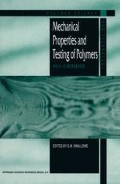Abstract
Polymers and their composites are important tribological materials for applications in aerospace, automotive components, micro machines and bio-systems. In the past, a considerable amount of research has been carried out to understand the mechanisms of friction and wear when a polymer surface interacts with another (hard or soft) surface1–5. This understanding has led to the greater use of polymeric materials and their composites in tribological applications. This article provides a brief review of the frictional properties of engineering polymers.
Access this chapter
Tax calculation will be finalised at checkout
Purchases are for personal use only
Preview
Unable to display preview. Download preview PDF.
References
Bowden F.P.and Tabor D., (1964) in The Friction and Lubrication of Solids, Part I und II, Claredon Press.
Briscoe, B.J., (1982) Tribology of polymers: State of an art,in Physicochemical Aspects of Polymer Surfaces,(ed. Mittal K.) Plenum Press.
Briscoe, B.J., (1980) The sliding wear of polymers: A brief review, in Fundamentals of Tribology, (eds. N. P. Suh and K. Saka) MIT Press, 733–758.
Briscoe, B.J., (1990) Materials aspects of polymer wear,Scripta Metallurgica, 24 (5), 839–844.
Briscoe, B.J., (1992) Friction of organic polymers, in Fundamentals of friction: Macroscopic Origins, (eds I. Singer and H. Pollock), Kluwer Academic Publishers, The Netherlands.
Greenwood J.A. and Tabor D., (1958) Proc. Phys. Soc., 71, 989–1001.
Tabor, D. (1974) Advances in Polymer Friction and Wear, Vol 5A, Plenum Press, New York and London, 5–30
Schallamach, A. (1952) J. Polymer Sci., 9, 385–396 (1952).
Briscoe B.J. and Tabor D. (1978) in Surface properties of polymers (eds. D. Clark and J. Feast ), John Wiley.
Ludema K.C. and Tabor D. (1966) Wear, 9, 329.
Archard J.F.(1957), Proc. Roy. Soc. Lond.,A 243, 190
Editor information
Editors and Affiliations
Rights and permissions
Copyright information
© 1999 Springer Science+Business Media Dordrecht
About this chapter
Cite this chapter
Briscoe, B.J., Sinha, S.K. (1999). Friction. In: Swallowe, G.M. (eds) Mechanical Properties and Testing of Polymers. Polymer Science and Technology Series, vol 3. Springer, Dordrecht. https://doi.org/10.1007/978-94-015-9231-4_23
Download citation
DOI: https://doi.org/10.1007/978-94-015-9231-4_23
Publisher Name: Springer, Dordrecht
Print ISBN: 978-90-481-4024-4
Online ISBN: 978-94-015-9231-4
eBook Packages: Springer Book Archive

